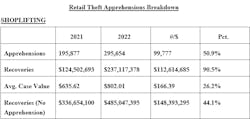Retail theft survey reports surge in apprehensions, dishonest employees
A 2022 survey of major retailers logged an increase in shoplifting apprehensions but also an increase in apprehensions last year for retail theft.
The 35th Annual Retail Theft Survey released recently by Jack L. Hayes International reported on over 340,000 incidents of apprehension for shoplifters and dishonest employees and the recovery of over $288 million from these thieves in 2022.
Some 26 large retail companies – including supermarkets, department stores, specialty apparel, and big-box retailers – participated in the survey, representing 22,182 stores across the U.S. with $704 billion in annual retail sales in 2022.
Eighty-one percent of the retailers reported an increase in shrink in 2022, which is reflected in their total apprehension and recovery statistics. Total apprehensions increased 45.6% and total recovery dollars from these apprehensions increased 70.5% in 2022.
Many retailers returned to making shoplifter apprehensions post pandemic and focused more of their attention on external theft issues in 2022. Our survey revealed shoplifter apprehensions and recovery dollars from those apprehensions increased significantly in 2022, up 50.9% and 90.5% respectively, said Mark Doyle, President of Jack L. Hayes International.
Recovery dollars, where no shoplifter apprehension was made, but merchandise was recovered, increased 44.1% in 2022. On the employee theft side, there was an increase in 2022 in both dishonest employee apprehensions and recovery dollars, 18.0% and 14.7% respectively.
A total of 340,488 shoplifters and dishonest employees were apprehended in 2022, with over $288 million in stolen profits recovered. This is an increase of 45.6% and 70.5% respectively from the previous year. The average theft case also saw a 17.1% increase to $846.11 in 2022. Only 10.9% of retail theft cases resulted in the recovery of stolen profits: for every $1.00 recorded by surveyed companies, $8.18 was lost to retail theft.Of the 340,488 people apprehended in 2022 by the survey’s participants, 295,654 of them were shoplifters – an increase of 50.9% from the previous year. Over $237 million was recovered from shoplifting apprehensions, a 90.5% increase from 2021.
Where no apprehension was made, $485 million was recovered, up 44.1% in 2022. The value of the average shoplifting case similarly climbed, rising 26.2% to $802.01.
The other 44,834 cases of the 340,488 shoplifting apprehensions made are those of dishonest employees, a number that saw a jump of 18% from 2021. Dollar recoveries from dishonest employee apprehension totaled over $50 million, up 14.7% from 2021, and the average dishonest employee case was valued at $1,136.93, a slight decrease of 2.8% from the previous year.Survey participants were asked why their shoplifting apprehensions and recovery dollars had either increased or decreased in 2022. The retailers that saw an increase attributed it to a return to making apprehensions post pandemic, increased ORC activity, less staff on the sales floor, fearlessness among thieves due to decriminalization and bail reforms, and a poor economy.
Those who reported a decrease cited a greater focus on merchandise recovery than apprehensions, understaffed police departments with reluctance to prosecute, structural changes in stores, and a hands-off, no apprehension policy for safety reasons.
Of the survey respondents, 72.7% reported an increase in shoplifter apprehensions and 73.1% saw a rise in dishonest employee apprehensions, recording an increasing trend toward shoplifting behaviors.
Additionally, 63.6% saw an increase in shoplifter recovery dollars, 66.7% reported an increase in shoplifting recovery dollars without an apprehension, and 84.6% responded with an increase in employee theft recovery dollars.
Additionally, participants were asked why their dishonest employee apprehensions and recovery dollars increased or decreased in 2022.
Those who recorded an increase responded with better trained AP/LP staff focusing on internal investigations, upgraded EBR programs yielding more internal cases, associate burnout resulting in associates rationalizing their thefts, exploitation of promotional programs to commit theft or fraud, and the tendency of associates to see shoplifters get away with theft and then try stealing themselves.
Alternatively, those who saw a decrease in employee theft specified updated EBR software that provided fewer opportunities for theft, increased use of CCTV, structural changes, fewer associates, and point-of-sale changes as potential reasons.
A total of $6.3 billion, or 89.1% of all theft losses, remains unaccounted for.
“This is a real balancing act for retailers right now,” Doyle said. “We know customer service is the best deterrent to shoplifting, as many shoplifters want and need privacy to commit their thefts. However, many retailers aren’t in a position to increase their payroll right now with sales being stagnant.
“There are some very positive anti-theft actions taking place, such as the INFORM Consumers Act, RFID technology combined with machine learning, artificial intelligence, facial and feature recognition, power tool activation technology, and self-service locking cases, among others.
“Reducing theft and loss will take a team effort going forward between retailers, law enforcement, and legislators.”



